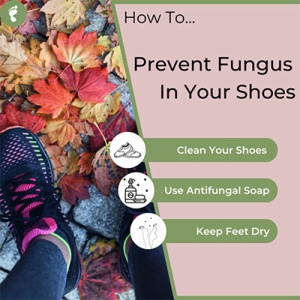Now that Labor Day has come and gone, the weather will start cooling down, which means it's officially time to put away the sandals and break out the closed-toe shoes. And we all know what that means: toenail fungus. It's important to take steps to prevent fungus from growing in your shoes, so in this blog post, I'll explain what fungus is, how it grows in shoes, and how to prevent it. Whether you're breaking out your favorite pair of boots or just grabbing a new pair of sneakers for the fall season, be sure to read on!
What is nail fungus?
Nail fungus, also known as onychomycosis, is a common condition that can affect both toenails and fingernails. The most common symptom of nail fungus is a white or yellow spot on the nail. At advanced stages, nail fungus causes the nails to become thick, brittle, and/or ragged. If left untreated, fungus can spread to other nails and even to the skin. Nail fungus is usually not painful, but it can be unsightly.
There are several things that can increase your risk of developing nail fungus. These include having diabetes, sweating a lot, having poor circulation, or having a weakened immune system. You are also at a higher risk of developing fungus if you get pedicures.
Can fungus grow in your shoes?
The short answer is YES! Fungus thrives in a moist environment. So, when you are wearing socks and closed-toe shoes all day long, moisture can build-up in your shoes and create a breeding ground for fungus. Sounds gross, I know. But there are steps that you can take to prevent a fungus fiesta in your shoes.
Prevention
One of the best ways to prevent fungal infections of the nails is to keep your feet clean and dry. When you're wearing closed-toe shoes, it's important to make sure that you're taking the time to wash your feet every day using Mod Pod Clean Antifungal Soap. Make sure that you're drying your feet thoroughly after they've been washed, paying special attention to in-between your toes. Leaving moisture in-between your toes can lead to athlete’s foot (a fungal infection of the skin).
If your feet are prone to sweating, you may want to consider using Mod Pod Fresh Antifungal Spray on your feet. Fresh Antifungal Spray fights odor causing bacteria and the power of peppermint will help keep your feet cool and dry all day.
You should also use Fresh Antifungal Spray in your shoes to kill fungal spores because just cleaning your feet is not enough. As I mentioned above, fungus lives and thrives inside of our shoes. Sterilizing your shoes is the key to break the vicious cycle of reinfection.
Another way to prevent fungal infections of the nails is to avoid sharing towels, socks, or other personal items with others. If you must share these items, make sure that you disinfect them before using them again. You should also avoid walking barefoot in public places, like locker rooms or pools. If you must walk barefoot, make sure that you're wearing sandals or flip flops.
Treatment
If you already have a fungal infection, we just need to add a few additional steps. In addition to cleaning your feet and shoes, we recommend a topical antifungal called Repair. Repair will not only work to eliminate fungus, but it will also reduce thickness to hep bring your nails back to life.
Repair works best in conjunction with laser therapy. Laser therapy is the most cutting-edge and effective way to treat nail fungus. Our HyperBlue laser is FDA cleared and there are no side effects! The laser promotes healthy nail growth by increasing the circulation to the area. One round of laser therapy consists of three treatments performed once a month over the course of three months. The treatments are painless and can be performed in approximately 15 minutes based on the number of toenails affected. There is no downtime after laser treatment.
Unfortunately, laser treatment is not covered by insurance at this time. Toenail fungus is considered cosmetic, much like cosmetic surgery. There is no medical harm in leaving your nails unsightly. However, FSA, HSA and Care Credit will cover this treatment option. The cost of laser therapy can also be broken down into monthly payments.
If you have a progressed case of fungus, then it might be necessary to remove the nail before performing laser treatment. In cases like this, the nail is too thick and infected for treatment to be effective. We need to start with a clean slate in order to get the best results possible. In the event that you need to have your toenail removed, you will start laser treatment approximately 2-3 weeks after the procedure. If you want to see what this procedure looks like, check out this YouTube video.
Laser treatment is not recommended for patients who are pregnant or have active cancer.
If you think that you may have a fungal infection of the nails, it's important to call us at 859-264-1141 or schedule an appointment online as possible. The sooner you come in, the easier fungus is to treat. And this is the perfect time of year to treat fungus because your toes will be hidden inside of your shoes and be ready when sandal season starts again!

